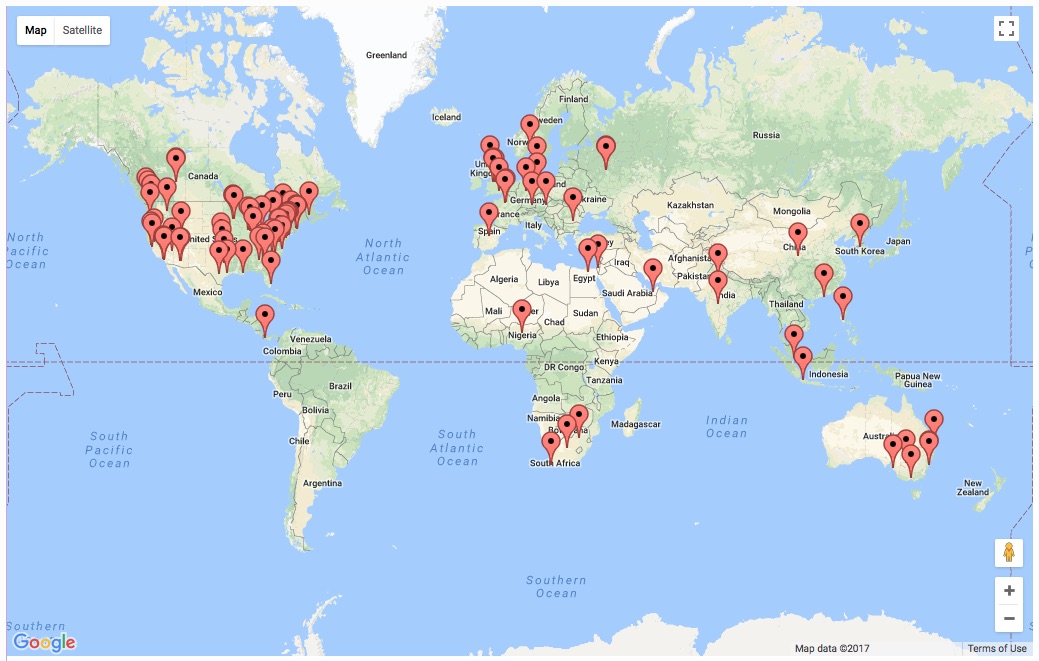Introduction
In service industries, centralized or distributed support models both have benefits and drawbacks. This document explores what these benefits and drawbacks are. Although there are people with strong opinions about which model is better, as you’ll read here, there are different benefits to both systems, and when implemented properly, those benefits can be achieved. When either system is implemented poorly, outcomes suffer. As explained below, a hybrid model is also possible that can achieve many of the benefits of both approaches.
Centralized Support Overview
Service industries generally operate from a centralized model, especially within larger organizations and companies. The Best Buy Geek Squad would be an example of this. For many businesses, instead of having an in-house specialist to provide support, they call to get help or have something fixed, and a person comes to fix it. For those working in these kinds of service industries, the center of community, friendship, and camaraderie is within the community of support providers at their central office. When the Best Buy Geek Squad comes out to setup your new television, they don’t stay for dinner.
In-House Support Overview
The alternative to centralization is to have a full-time on-site in-house support person. When small businesses grow to a certain size, they reach the point where hiring a person full time can be less expensive than paying higher hourly rates to have a consultant to come in occasionally or part-time. Larger organizations and businesses may have many support people on staff who are spread around in the areas where they are needed for easier access. In this business model, the support people may feel a greater sense of belonging, community, and camaraderie with the people they are serving. Knowing more about those we serve, helps us serve them better, this combined with greater accessibility, creates opportunities for preventative and proactive approaches.
Benefits of Centralization
There are a number of benefits to having a centralized service model:
- Scalable. With a centralized team of support people, it’s possible to respond to just about any need with just the right amount of support.
- Specialized. Specialists in the team, with much more experience than a generalist, can deliver higher quality support as needed — shared across multiple units.
- Better Tools. When specialized repair tools and resources are shared, they can be of higher quality and more variety.
- Collaborative. A central team of support specialists are more likely to build collaborative and supportive relationships.
- Standardized. When people are working together as a team, it’s easier to arrive at and implement standard practices.
- Load Balanced. Having cross training and redundancy of support personnel ensures users get support even if someone is on vacation or sick. It’s also less stressful for an employee who knows that they can take time off without it impacting their work negatively.
Overall, the outcome of a centralized service model should be a higher quality of support and a greater quantity of support. In the long-term, it should be better for all people involved. A win-win situation.
Benefits of Distributed Support
Here are some of the benefits of distributed support:
- Integrative. There’s a significant team-building and unifying benefit from having all employees working together having an opportunity to collectively experience shared successes. When support staff have a home among those they support, and have a sense of belonging, they can work more smoothly as a team.
- Immediate. Being more easily accessible, support people who are close to those they are serving will be utilized more. Even the simplest elevator conversation can lead to a breakthrough in efficiency.
- Trust Building. Being part of the community they serve, support specialists are more trusted. Trust includes believing that you can rely on someone, and that you believe in their level of competency.
- Engaging. When service and support employees are daily working side-by-side with the people they are supporting, they can make sure people are aware of and utilizing best practices and following established standards and policies.
An Analogy to Cluster Storage and Computing
Anyone who has had their files stored on different hard drives knows that each drive will inevitably have free space left on it, sometimes a lot of unused free space.
A RAID file system allows you to combine many different hard drives into what the computer perceives is a single large drive. Previously unused space on many different drives is combined and available for use rather than scattered around.
Cluster Computing and Network File Storage systems provide this same efficiency. Technology is centrally located, and utilized by a large group of people, significantly reducing the otherwise unused drive space and underutilized computing power that might have been scattered around throughout an organization.
Well, the same principles of efficiency are present with human capital management strategies for service industries. Centralized service delivery models create a cluster of people in one location who can be called out on demand as needed, rather than being spread around an organization.
Fluctuations in Support Needs
When support people are distributed, they will likely experience the inevitable fluctuation of workload and support needs from one day to the next.
In service industries, it’s unlikely that workers will each individually have precisely 40 hours of work to accomplish in a given week if they are supporting a specific group of users.
From week to week, the support needs change. Usually what happens is that support people put in more hours to keep up, and sometimes quality suffers.
A Lesson From Urban Planning
For several decades, municipalities have struggled with a planning model that was largely dependent upon automobile ownership and use.
Rather than having walkable communities with mixed use urban spaces, cities have been designed to have shopping malls on one side of town, an industrial park on the opposite side of the city, a business park might be on the outskirts of town, with suburbs and sprawl were situated elsewhere. The downtown would be mostly office buildings. In none of these places were there opportunities or venues where community could be built.
New urbanism and walkable communities are designed so that people might live, work, shop, eat, and socialize all within the same neighborhood or downtown area.
With this in mind, we can think about service delivery models. A centralized service delivery model has all employees checking in at a central office and going out to deliver services as needed. Not as many opportunities exist for building collaborative relationships with those being served.
A distributed service delivery model is like new urbanism and walkable communities. From day-to-day, service people share the same office space and facilities as those they serve. Relationships are more easily established. The working conditions are such that collaboration is fostered and less of an effort.
In some office environments, people serving different roles work in the same proximity: graphic designers, sales staff, marketing, office managers, receptionists, secretaries, and tech support staff. This helps build relationships and provides easy access between different team members.
Imagine separating out one group of employees based on their role, and not allowing them to interact socially with the rest of those in the organization or company. Rather than feeling like they are part of the bigger team of employees they serve, they’d likely feel removed and possibly less valued.
A Lesson From Permaculture
In the midwest agricultural states, it’s common to have thousands of acres dedicated individual crops like corn or soybeans. In a permaculture model, food and other vegetation is grown strategically together to create a self-maintained habitat.
Huge cubicle farms of employees grouped together by specialty reflect a monoculture model rather than a permaculture model. Rather than building small diversified workplace community centers, cubicle farms are focused on workplace efficiency.
The Intersection of Arts and Sciences
There’s been a lot of talk about interdisciplinary collaborative efforts. A liberal arts and sciences environment is based on the idea that a diversity of academic disciplines, when interwoven, can create an environment that fosters creativity and innovation. A blended workplace community of employees creates an opportunity for interdisciplinary partnerships.
A Lesson from Healthcare
In the traditional approach to healthcare, you visit your doctor once a year, and get an annual physical. The doctor visit may last 10 to 15 minutes — just long enough to get vitals, check ears, check throat, and listen to the heart and lungs. No exploratory lab work is done unless some symptoms have manifested that suggest further exploration is needed.
Only when there’s acute pain or an injury do we visit the hospital outside of our regular annual physical / checkup. As a result, many life threatening conditions and illnesses fester underneath the surface. By the time they are identifiable as symptoms, it’s too late to prevent them.
In the new model of healthcare, visits to the doctor are more regular and may last 60 to 90 minutes. The healthcare provider learns about your home life, work life, diet, exercise routine, sleep, and other factors that impact health. Extensive lab work is done to identify indicators of potential health problems on the horizon. This approach to healthcare seems to take more effort, yet in the long run can help prevent very costly surgery and life threatening illnesses that are all preventable. Because of the relationship established between doctor and patient, it’s more likely that the doctor can encourage, equip, and inspire the patient to make life changing life choices and changes in diet and exercise.
If we we take this approach to service industries, we will find that problems are less severe, less frequent, and cost less to fix in the long run.
Hybrid Solution
A hybrid model of service delivery would call for centralized administration and oversight of support staff, but support staff would have their offices mixed in with those they are supporting. An effort would be made to maximize ‘time in the field’ and reduce time in meetings and conferences. This support model provides benefits of both centralized and distributed support. Employees would report to the administrative members within the group they support, and also report to their central office management.
UPDATE: 5 May 2023
I’ve written an update and addendum to the above article. To learn more, read, “Tech Support: Small Scale — At Scale.” [View]
__________________
Page Visitors
Thanks for taking an interest in this article and sharing it with others. The maps below show recent page visitors from around the world. It’s nice to see there’s ongoing interest in this article more than eight years years after it was published.
Below are recent visits as of 5 May 2023

Below are recent visits as of 2 Sep 2017

Document History
- 5 May 2023 at 4:20 PM — Added addendum note at the bottom of the document to an additional related article. Updated page formatting for the WordPress block editor. Added updated recent visitor map.
- 8 Feb 2015 at 9:36 PM — Document initially posted.


